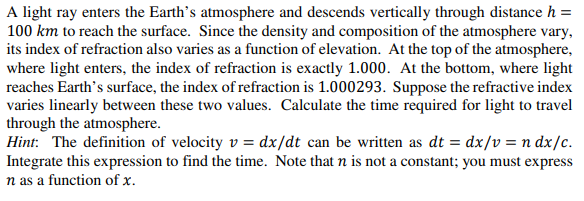A light ray enters the Earth's atmosphere and descends vertically through distance h = 100 km to reach the surface. Since the density and composition of the atmosphere vary, its index of refraction also varies as a function of elevation. At the top of the atmosphere, where light enters, the index of refraction is exactly 1.000. At the bottom, where light reaches Earth's surface, the index of refraction is 1.000293. Suppose the refractive index varies linearly between these two values. Calculate the time required for light to travel through the atmosphere. Hint: The definition of velocity v = dx/dt can be written as dt = dx/v = n dx/c. Integrate this expression to find the time. Note that n is not a constant; you must express n as a function of x.
A light ray enters the Earth's atmosphere and descends vertically through distance h = 100 km to reach the surface. Since the density and composition of the atmosphere vary, its index of refraction also varies as a function of elevation. At the top of the atmosphere, where light enters, the index of refraction is exactly 1.000. At the bottom, where light reaches Earth's surface, the index of refraction is 1.000293. Suppose the refractive index varies linearly between these two values. Calculate the time required for light to travel through the atmosphere. Hint: The definition of velocity v = dx/dt can be written as dt = dx/v = n dx/c. Integrate this expression to find the time. Note that n is not a constant; you must express n as a function of x.
Principles of Physics: A Calculus-Based Text
5th Edition
ISBN:9781133104261
Author:Raymond A. Serway, John W. Jewett
Publisher:Raymond A. Serway, John W. Jewett
Chapter25: Reflection And Refraction Of Light
Section: Chapter Questions
Problem 7OQ: Light traveling in a medium of index of refraction n1 is incident on another medium having an index...
Related questions
Question

Transcribed Image Text:A light ray enters the Earth's atmosphere and descends vertically through distance h =
100 km to reach the surface. Since the density and composition of the atmosphere vary,
its index of refraction also varies as a function of elevation. At the top of the atmosphere,
where light enters, the index of refraction is exactly 1.000. At the bottom, where light
reaches Earth's surface, the index of refraction is 1.000293. Suppose the refractive index
varies linearly between these two values. Calculate the time required for light to travel
through the atmosphere.
Hint: The definition of velocity v = dx/dt can be written as dt = dx/v = n dx/c.
Integrate this expression to find the time. Note that n is not a constant; you must express
n as a function of x.
Expert Solution
This question has been solved!
Explore an expertly crafted, step-by-step solution for a thorough understanding of key concepts.
This is a popular solution!
Trending now
This is a popular solution!
Step by step
Solved in 2 steps

Knowledge Booster
Learn more about
Need a deep-dive on the concept behind this application? Look no further. Learn more about this topic, physics and related others by exploring similar questions and additional content below.Recommended textbooks for you

Principles of Physics: A Calculus-Based Text
Physics
ISBN:
9781133104261
Author:
Raymond A. Serway, John W. Jewett
Publisher:
Cengage Learning

Physics for Scientists and Engineers: Foundations…
Physics
ISBN:
9781133939146
Author:
Katz, Debora M.
Publisher:
Cengage Learning

College Physics
Physics
ISBN:
9781285737027
Author:
Raymond A. Serway, Chris Vuille
Publisher:
Cengage Learning

Principles of Physics: A Calculus-Based Text
Physics
ISBN:
9781133104261
Author:
Raymond A. Serway, John W. Jewett
Publisher:
Cengage Learning

Physics for Scientists and Engineers: Foundations…
Physics
ISBN:
9781133939146
Author:
Katz, Debora M.
Publisher:
Cengage Learning

College Physics
Physics
ISBN:
9781285737027
Author:
Raymond A. Serway, Chris Vuille
Publisher:
Cengage Learning

College Physics
Physics
ISBN:
9781305952300
Author:
Raymond A. Serway, Chris Vuille
Publisher:
Cengage Learning

Physics for Scientists and Engineers with Modern …
Physics
ISBN:
9781337553292
Author:
Raymond A. Serway, John W. Jewett
Publisher:
Cengage Learning

Physics for Scientists and Engineers
Physics
ISBN:
9781337553278
Author:
Raymond A. Serway, John W. Jewett
Publisher:
Cengage Learning